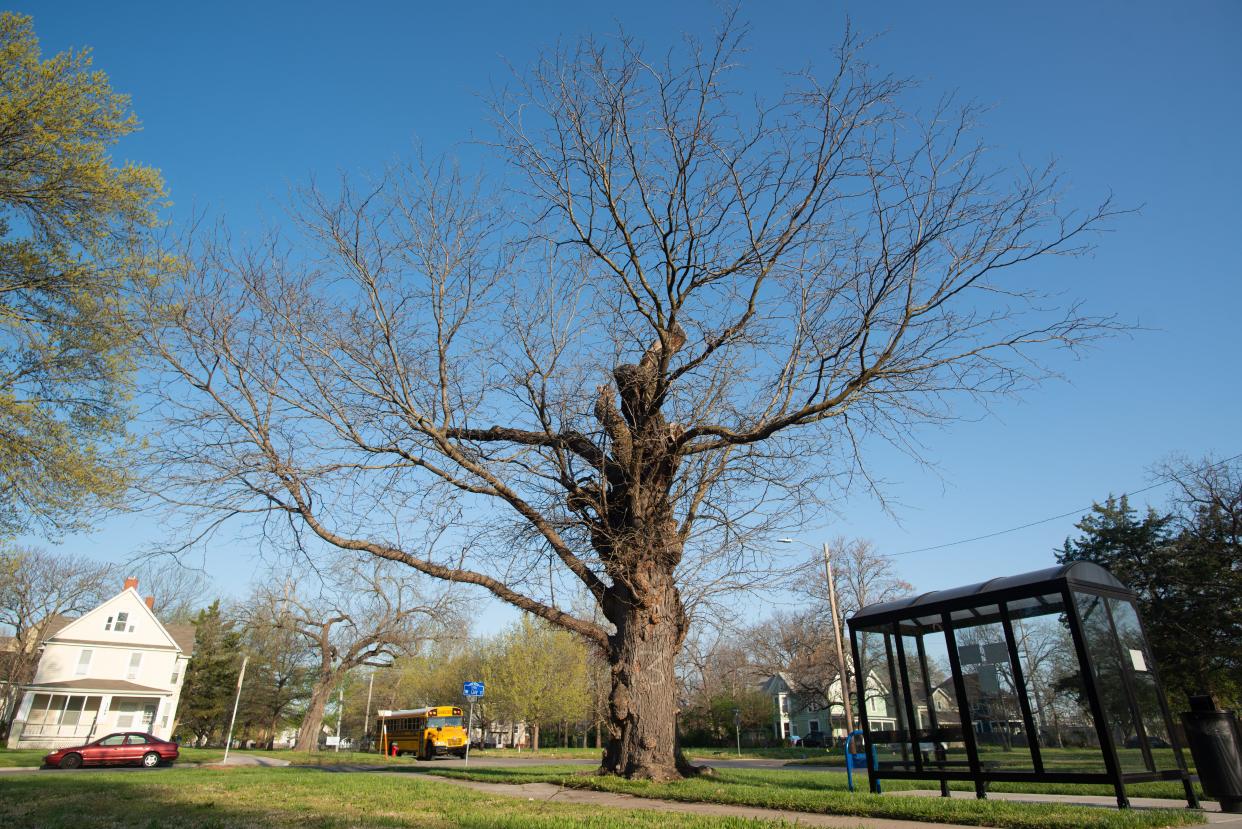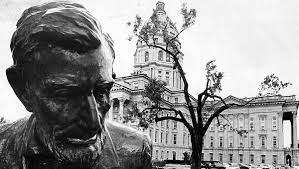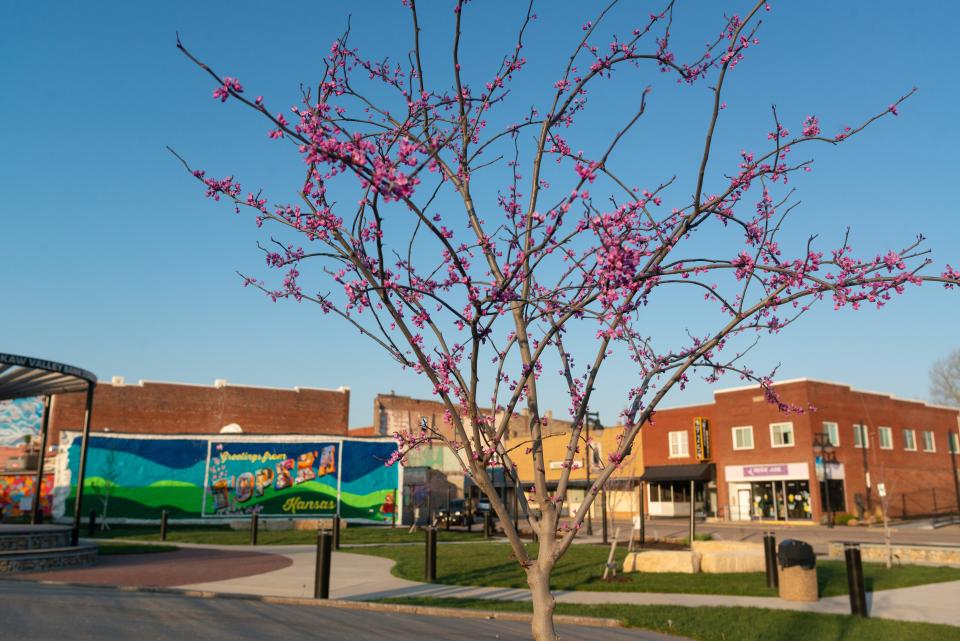Have you seen the 5 trees that helped make Topeka what it is today? Celebrate them Arbor Day.

The gnarled old locust tree standing at the southeast corner of S.W. Huntoon and Clay is the oldest tree in Topeka, according to a plaque located there.
That tree is among five significant Topeka trees or groups of trees The Capital-Journal is recognizing to mark Arbor Day, which is Friday.
Here is the list:
1. The oldest tree in Topeka
Thirty-two students in an eighth-grade class at nearby Central Park School arranged for the plaque identifying it as Topeka's oldest tree to be attached in 1913 to the tree at S.W. Huntoon and Clay, according to the website of the Kansas Historical Society.
The plaque was later moved to a place on the ground near the tree's base, that site says.
"Believed to date from the city's early history, the tree may have been full-grown when Kansas was opened as a territory in 1854," it says. "Trees commonly were planted as guideposts along the trail that carried travelers from Fort Leavenworth to the Santa Fe Trail junction near Burlingame."
More: Jennie Chinn, who died Saturday, ran Kansas Historical Society for 18 years. Her job gave her joy.

The locust tree drew students' attention after it was mentioned in "The Price of the Prairie," a book about post-Civil War settlers in Kansas published in 1910 by Margaret Hill McCarter, the namesake for McCarter Elementary School at 5512 S.W. 16th.
The historical society website says a woman who taught at Central Park School in 1913 said the tree might not have been the area's oldest, but "it was supposed to be the oldest tree between the Statehouse and Shunganunga Creek to the southwest."
City forester Travis Tenbrink said Topeka's city government has no official record or documentation of the tree's being Topeka's oldest, but he has no reason to doubt that.
"We continue to trim the tree as needed, and actually have it on our schedule to be trimmed in the next few months," he said. "We are also planning to do some chemical treatments to help support, and hopefully improve the root system of the tree."
2. Statehouse Cottonwood

For more than a century, a massive, 90-foot-tall cottonwood tree stood on the Kansas Statehouse grounds, just southeast of the Capitol.
The historical society website says legend has it that the tree grew from a stake workers drove into the ground while building the Statehouse. Another account says the tree was already present as a sapling when construction of the Statehouse began in 1866.
Kansas legislators, perhaps inspired by its nearby presence, voted in 1937 to choose the cottonwood as the Kansas State Tree.
The Statehouse cottonwood survived Topeka’s historic 1966 tornado, though it was badly damaged. Tree surgeons replaced a large piece of its trunk with concrete in an effort to keep it alive.
In the years that followed, the tree slowly died. All branches above the main trunk were cut down in 1983. The stump was removed in 1984.
More: What happened to Amelia Earhart? This $15 million Kansas museum will honor the pilot's legacy
3. North Topeka redbuds

Claire Swogger's favorite tree was the redbud.
The Topeka woman and her husband, Kaw Valley Bank & Trust Co. owner Glenn Swogger, consequently gave the name "Redbud Foundation" to the philanthropic organization they formed to benefit various causes.
Those included creating Redbud Park, a public gathering place that features various redbud trees.
The park is located on the site of what used to be a parking lot at the southeast corner of N. Kansas Avenue and Gordon, in downtown North Topeka's NOTO Arts District.
Claire Swogger died in 2017, but Glenn Swogger survived long enough to take part in ribbon-cutting ceremonies held at the park in 2019. He died last August.
4. Fidelity State Bank seedlings

Ten months after the 1966 tornado killed many trees in Topeka, Fidelity State Bank & Trust Co. began a 53-year Arbor Day tradition of giving away seedlings it had bought.
“We started giving out trees in the lobby of the bank,” the bank's late president and CEO, Anderson Chandler, told The Capital-Journal in 2016. “We only had two locations then. By the next year, we decided that the best way to get more trees planted was to give them to schools.”
The tradition continued through 2020.
Members of the Topeka History Geeks Facebook group spoke positively this past week on that site of the role in that effort played by Chandler, who died in 2019.
"He was a very community-oriented businessman and a great Topeka citizen," said Topekan Kurt Kieffer.
5. Lake Shawnee Arboretum

The late Capital City Bank president Frank Sabatini spearheaded efforts to create and develop the Lake Shawnee Arboretum, which contains numerous trees and stands just southwest of S.E. 37th and West Edge Road.
The site was an open field when Sabatini set out in 1993 to make it an arboretum. That arboretum was dedicated in 1997.
"Emotionally, it's just kind of a dream come true for me to leave some kind of legacy," Sabatini told The Capital-Journal at rededication ceremonies held in 2005.
Sabatini died in October.
Topeka is site of five 'champion' trees
The Kansas Forest Service says Topeka is the location of five "champion" trees, which are the largest of their type in Kansas. A report on the KF website says those trees are as follows:
An 87-foot tall willow oak in Gage Park, 635 S.W. Gage Blvd.
A 69-foot-tall Texas red oak in Crestview Park, 4801 S.W. Shunga Drive.
A 66-foot-tall sugarberry in Gage Park.
A 54-foot-tall quaking aspen at 654 S.W. Watson Ave.
A 16-foot-tall roughleaf dogwood at Forbes Field.
Tim Hrenchir can be reached at threnchir@gannett.com or 785-213-5934.
This article originally appeared on Topeka Capital-Journal: On Arbor Day, celebrate 5 trees that are part of Topeka history

